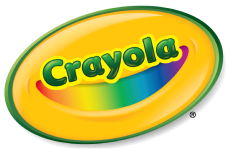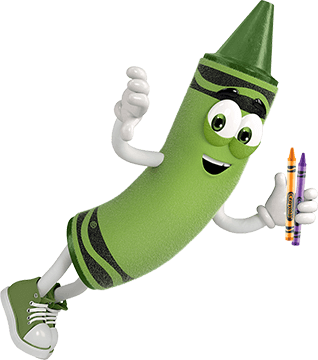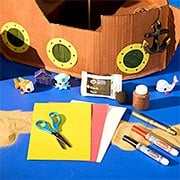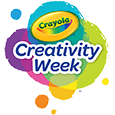La primera parte del nombre del color del crayón CRAYOLA es un adjetivo que describe el nombre del segundo color en el crayón. El verde-azul es realmente azul con un toque de verde, mientras que el azul-verde es realmente verde con algo de pigmento azul en el crayón. Lo mismo ocurre con el naranja-rojo y el rojo-naranja.
Si tiene preguntas adicionales, ¡nos encantaría saber de usted! No dude en llamarnos o enviarnos un mensaje de texto al 1-800-272-9652 de lunes a viernes entre las 9 a. m. y las 4 p. m., hora del este. Si prefiere enviarnos un correo electrónico, visite nuestra página de contacto.
Si tienes preguntas adicionales, ¡nos encantaría saber de ti! No dudes en llamarnos o enviarnos un mensaje de texto al 1-800-CRAYOLA días laborables entre las 9 AM y las 4 PM hora del Este. Si prefieres enviarnos un correo electrónico, visita nuestra página de contacto.
Preguntas relacionadas
Explora respuestas a preguntas comunes, consejos útiles para eliminar manchas e ideas creativas para aprovechar al máximo nuestros materiales de arte y recursos gratuitos.
-
Primary Colors: Primary colors are the foundation for creating other colors. They cannot be created by mixing other colors together. The primary colors are:
- red
- blue
- yellow
Secondary Colors: Secondary colors are created by mixing two primary colors.
- red + yellow = orange
- yellow + blue = green
- blue + red = violet
Tertiary Colors: Tertiary colors are created by mixing primary colors and adjacent secondary colors on the color wheel.
- red + orange = red orange
- green + yellow = yellow green
- blue + violet = blue violet
Need a visual? Learn more about blending and mixing colors on Crayola's color theory page.
-
Throughout Crayola's history, several crayon colors have been retired, marking significant moments in the evolution of our vibrant palette.
1990
For the first time in Crayola history, eight colors were retired and placed in the Crayola Hall of Fame: blue gray, green blue, lemon yellow, maize, orange red, orange yellow, raw umber, and violet blue. Eight new colors were added: cerulean, dandelion, fuchsia, jungle green, royal purple, teal blue, vivid tangerine, and wild strawberry.2003
Celebrating a century of bringing color to the world, Crayola introduced four new colors named by Crayola fans! To make room for the new hues, we bid farewell to blizzard blue, magic mint, mulberry, and teal blue. The four new colors that were introduced are: inchworm, jazzberry jam, mango tango, and wild blue yonder. Kudos to our hue heroes - the consumers who voted in the "Save the Shade" campaign, ensuring burnt sienna stayed in the pack.2017
To mark National Crayon Day on March 31st, we announced Dandelion was leaving the pack. To honor this iconic color, we sent Dandelion on a retirement tour to his favorite places. His replacement, Bluetiful, was announced on May 5, 2017.Looking for more historical facts about our colorful company? We've got them on the Crayola History page!
-
In 1993 we conducted a poll to find out the most popular colors in America. Blue was voted the most popular Crayola Crayon color. Rounding the top ten were red, violet, green, carnation pink, black, turquoise blue, blue green, periwinkle and magenta.
In 2000, we did another Crayola Color Census, and blue again reigns as number one! Six other shades of blue finished in the Top 10 including cerulean, midnight blue, aquamarine, periwinkle, denim and blizzard blue. The other colors rounding out the list included purple heart, caribbean green and cerise.In 2025, Crayola announced the results of its first Global Color Vote for National Color Day on October 22, revealing that we share a common connection to certain hues. Earlier in 2025, consumers from 183 countries (94% of the countries worldwide) cast their votes, and the top three favorite Crayola colors are Cerulean (blue), Robin’s Egg Blue and Wisteria.
-
Crayola® did not invent the crayon. The "modern" crayon originated in Europe, initially made from a mixture of charcoal and oil, later replaced by powdered pigments. Wax was later substituted for oil, making the sticks sturdier and easier to handle.
In 1902, Crayola Crayons were invented by Binney & Smith and first offered for sale in 1903. The trade name "Crayola" was coined by Mrs. Edwin Binney, combining "craie" (French for chalk stick) and "oleaginous" (oily).
Crayola manufactures over 3 billion crayons each year, primarily made from paraffin wax and color pigment. Learn more about Crayola's colorful history at Crayola.com.
-
Recognizing a need in schools for safe and affordable wax crayons, Binney & Smith created the first box of eight Crayola Crayons in 1903. Sold for a nickel, this box included red, orange, yellow, green, blue, violet, brown, and black.
The Crayola name was coined by Alice Binney, wife of company founder Edwin Binney and a former schoolteacher. It combines the French word for "chalk" ("craie") with "ola," meaning "oily."
Want to know more about our colorful history? Check out the details on Crayola's history page.




